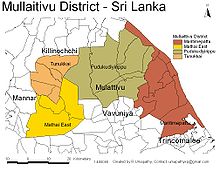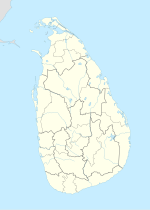
Back Mullaitivui csata Hungarian Bitwa pod Mullaitivu Polish Batalha de Mullaitivu em 2009 Portuguese 2009 முல்லைத்தீவுப் போர் Tamil Trận Mullaitivu (2009) Vietnamese
This article's factual accuracy may be compromised due to out-of-date information. (August 2010) |
| Battle of Mullaitivu | |||||||||
|---|---|---|---|---|---|---|---|---|---|
| Part of the Sri Lankan Civil War, 2008–2009 SLA Northern offensive | |||||||||
| |||||||||
| Belligerents | |||||||||
|
| |||||||||
| Commanders and leaders | |||||||||
|
Sarath Fonseka: Nandana Udawatta Laksiri Waduge | Velupillai Prabhakaran | ||||||||
| Strength | |||||||||
|
Sri Lanka Army: 59 Division: > 7,000[1] 593 Brigade 7 Gemunu Watch | Unknown | ||||||||
| Casualties and losses | |||||||||
| Unknown | Unknown | ||||||||
Location of Mullaitivu | |||||||||
The Battle of Mullaitivu was a land battle fought between the Sri Lankan Military and the Liberation Tigers of Tamil Eelam (LTTE) for the control of the town of Mullaitivu in the Northern Theatre of Eelam War IV during the Sri Lankan civil war. The town of Mullaitivu was the last stronghold of the LTTE. The government declared on 25 January 2009 that its troops had entered the town and were consolidating their positions.[2]

The Sri Lanka Air Force had been attacking LTTE positions in and around Mullaitivu for several days before the government troops claimed to have entered it.[3] After the Battle of Kilinochchi (23 November 2008 – 2 January 2009), during which the Sri Lankan military captured the LTTE stronghold of Kilinochchi, the Ministry of Defence had stated that the military's next target was Mullaitivu.[4] Leaflets had been dropped by the Sri Lanka Air Force earlier over the town, urging civilians to come to government controlled "safe zones".[5] The government also suspended all civil administration work on 23 January to allow public servants to leave the area.[6] The army had allowed a 32 kilometres (20 mi) "safe area" inside the war zone for civilians to exit. Independent aid agencies report about 230,000 civilians were inside the war zone around the northern city.[7]
- ^ "Sri Lanka Says Soldiers Enter Last Town Held by Tamil Tigers". Bloomberg. 25 January 2009.
- ^ "Troops enter Mullaittivu; LTTE main garrison town falls". Ministry of Defence of Sri Lanka. Defence.lk. 25 January 2009. Archived from the original on 5 February 2009. Retrieved 25 January 2009.
- ^ "SL Army captures LTTE camp, kills six rebels". Zee News. 23 January 2009. Archived from the original on 31 January 2009. Retrieved 25 January 2009.
- ^ "Sri Lankan troops pursue Tamil Tigers". Taipei Times. 4 January 2009. Archived from the original on 4 February 2009. Retrieved 25 January 2009.
- ^ Najmuddin, Jamila (23 January 2009). "Air force drops leaflets over safe zones in Mullaitivu". Daily Mirror. Archived from the original on 5 February 2009. Retrieved 25 January 2009.
- ^ Kamalendran, Chris (25 January 2009). "Govt. clears Mullaitivu for final assault". The Sunday Times. Retrieved 25 January 2009.
- ^ Cite error: The named reference
Sri Lankan troops capture last big rebel town -armywas invoked but never defined (see the help page).
